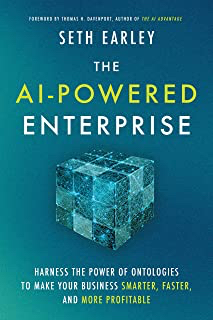By William Carmichael
At first glance, artificial Intelligence (AI) may appear an odd topic to review for an HR publication. Afterall, what exactly does AI have to do with HR? Surprisingly, more than you might think and for the HR practitioner, the requirement to understand and embrace this technology has never been more pressing. In this first of three reviews on AI, I will provide a quick summary of a recent best seller and how each can benefit the HR practitioner from three distinct vantage points; AI as a change agent, AI as the next paradigm shift, and AI as a leadership strategy.
From a change agent perspective, The AI-Powered Enterprise: Harness the Power of Ontologies to Make Your Business Smarter, Faster, and More Profitable by Seth Earley does an excellent job of defining AI as a transformational inevitability for both business and industry. The author does an excellent job of explaining how the organizational dynamics of AI directly impact that organization’s global success. And by the way, HR is smack dab in the middle of it all.
What AI Is Not
For the purposes of this first review, it is important to share what I feel AI is and is not. Allow me to begin with what AI is not. The problem with AI is that it’s vague. It is not, despite what we may think, robots taking over the world although Hollywood helps secure a very bad reputation for it, i.e.; The Terminator, The Matrix, the menacing presence of Hal 9000 from 2001: A Space Odyssey. For the moment, the reality of automated beings having the ability to think and decide like humans do is at best, decades away. However, it is uncannily proficient at asking the right programmed questions but for now, that is all.
What AI Is
AI is, for all intents and purposes, informational data that has intent, application, and benefit. In other words, it is a useful technology. The AI-Powered Enterprise allows us a peek inside to what many erroneously think to be an impenetrable domain. AI simply complements human intelligence and allows us to become faster and smarter at the tasks we are performing based on the deluge of data we are generating. A simple example of this is the use of chatbot. A chatbot is a computer program that simulates human conversation through voice commands or text chats or both. This automated program interacts with customers like a human would and cost little to nothing to operate. Chatbots also efficiently screen potential candidates 24/7 and are not limited by time or a physical location. This makes its implementation appealing to many businesses that may not have the manpower or financial resources to keep HR employees working around the clock.
Applications are enormous for this technology which The AI-Powered Enterprise makes very clear. As the author states in Chapter 8’s- Accelerating Employee Productivity, “There is a better way to manage internal information: an integrated knowledge management system. The right knowledge system supports employee job functions and workforce management; reduces the need for training, onboarding, and human resources functions; improves efficiency; and reduces employee turnover. We can think of these applications in the context of the lifecycle of an employee- from recruiting, screening, and hiring through training, skill development and ongoing day-to-day knowledge work.”
Now this is all well and good you might say but can AI help in managing the process? The answer is a clear and unequivocable yes, but the management must be built in; what our author refers to as “smart-object data points” using an organization’s existing technology.
What is Ontology?
AI as a change agent can be done but as with any IT function, AI is inherently theoretical. In other words, needed functions must be built-in to any desired outcome and this our author refers to as ontology. Ontology is an area of philosophy that deals with the nature of being, or what exists. An ontology is a holistic digital model of every piece of information that matters to the business, from processes to products to people. It reveals what is going on inside the business and it is what makes the difference between the promise of AI and then delivering on that promise. In a nutshell, ontologies are frameworks for representing shareable and reusable knowledge across a domain. Their ability to describe relationships and their high interconnectedness make them the bases for modeling high-quality, linked and coherent data.
Why this is a Must Read
The AI-Powered Enterprise; Harness the Power of Ontologies to Make Your Business Smarter, Faster, and More Profitable examines two fundamental questions:First, how will the future be different as a result of AI? And Second, what must companies do to stake their claim on that future? This book is the first to combine a sophisticated explanation of how AI works with a practical approach to applying AI to the problems of the business; from the customer experience to business operations to product development to human resource management.
Although our author presents AI across organizational domains, those specific to Human Resource Departments allow it to automate repetitive, low-value tasks thus increasing the focus on more strategic work.
AI tools automate common HR tasks like:
- benefits management or handling common questions or requests.
- the automation of tedious, time-consuming tasks to;
- the augmentation of human capabilities and;
- the amplification of human functions.
When it comes to AI for HR, companies are:
- using chatbots to look up information such as company policies or benefits.
- identifying the best candidates based on publicly available data, like social media profiles.
- providing recommendations for learning and training to employees.
- using chatbots to engage with candidates during recruitment.
- screening and assessing candidates during recruitment.
Companies planning to invest in AI this year are targeting:
- chatbots for employee self-service, such as changing benefits or requesting time off.
- the ability to identify employees who are disengaged or at risk of leaving.
- suggestions of job openings or career paths for current employees.
- help in the performance management process.
- customization or improving benchmarking in compensation.
Structure and Layout
At 272 pages, The AI-Powered Enterprise reads much like a user-friendly textbook where readers will benefit from each of its eleven chapters regardless of topic chosen. It is extremely well researched. I specifically targeted Chapter 8’s review of Accelerating Employee Productivity as my first entry but can easily see where someone from sales might select Chapter 3’s – Customer Experience: The Front Line of the Battle. Two immediate benefits readers will see comes from the key takeaways at the end of each chapter as well as an excellent Glossary that takes the mystery out of AI terminology.
Who Will Benefit Most from This Book?
Human Resource Professionals, Corporate Trainers, Information Officers, Marketing Officers, Senior Management
About the author: Seth Earley is CEO of Earley Information Science (EIS), a leading consulting firm focused on organizing information for business impact, with expertise in knowledge strategy, data and information architecture, search-based applications, and information findability solutions. He has developed information management strategies for a wide variety of organizations including Fidelity Investments, the Internal Revenue Service, Abbott Laboratories, Plymouth Rock Insurance, 3M, Honeywell, and Gartner Group.

william.carmichael@strayer.edu
www.strayer.edu
